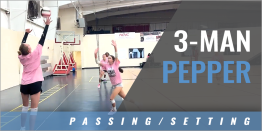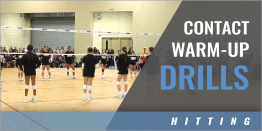|
Provided by: AVCA
Activity: Use one less volleyball than there are number of players on your team. The players must work as a team to carry the balls through a specified course, however they cannot touch the balls with any part of their body below the waist or above the armpit. This drill forces the team to pull together and strategize to accomplish the task. Equipment: Volleyballs or balloons (one less than the number of players in the activity). If balloons are used it's important to have extras in case some pop. Space/Location: Gym, outside or wherever a course can be set up. Coaching Points: Coach as little as possible. Provide enough volleyballs so that there is one less ball than the number of players you have participating (for example, if you have 12 players, you will need 11 volleyballs). Simply give the team the scenario that they are to transport the volleyballs all at the same time (i.e., balls and players must all go together) along the specified course. However, once the balls are in place (or the team starts on the course) the balls can only touch the player's bodies above the waist and below the armpit, no hands, arms, legs, chins, etc.(i.e., the only contact is on the torso). It is also important to keep the volleyballs on the outside of their clothing (for this increases the challenge and the feelings of success). The course can be varied based on the degree of difficulty and amount of time available. Course ideas from simple to difficult:
Coaches can decide how difficult they want to make the activity. Additional Variations: Have two (or more) groups race each other. This puts added panic and rushing into the activity. Most often the group that wins is the group that is slow and steady. (This helps athletes learn patience and focus during pressure situations). Adding difficulty:
Breakdown: The entire group must walk together. There must be some method of keeping the group together and moving at the same time. If the front of the line gets going too fast they will be separated from the back of the line and balls will fall. Transfer: During games and practices players learn to help each other accomplish the goal. Players learn how to share their ideas and how to physically work together to obtain the desired outcome. Players develop the satisfaction of working together to be successful. Evaluating the Success of the Drill: It should not take too long for the team to get an idea together of how to transport the balls. However, they should have to deal with some frustration along the way: dropping the balls, some members not keeping up with others, an obstacle. The success comes in the team's ability to maintain their focus and finish the task despite setbacks. The more difficult the course/task the more frustration they will have to overcome and the more satisfaction.
|






